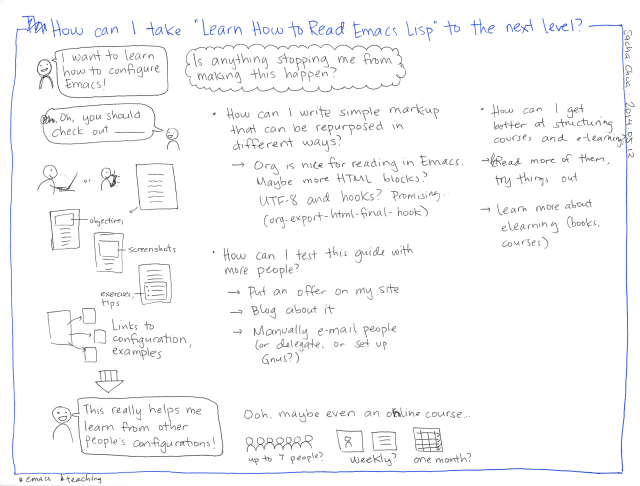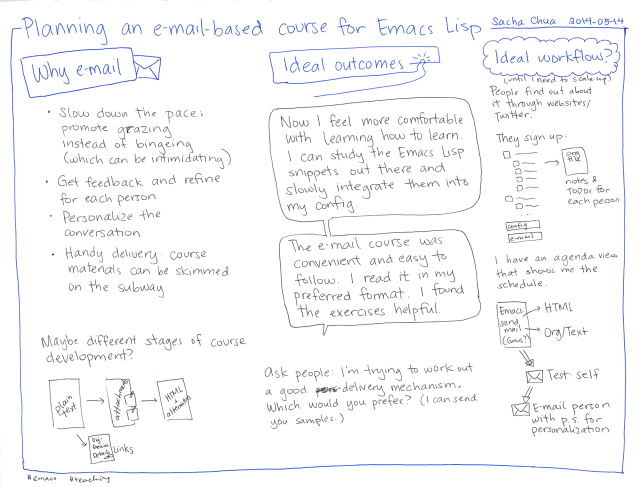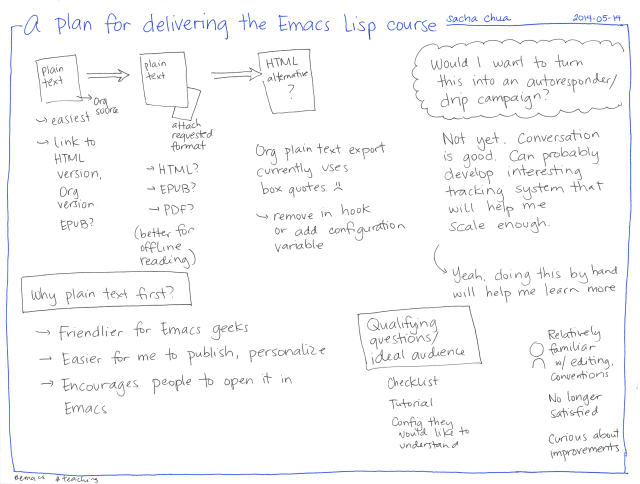Planning an e-mail-based course for Emacs Lisp
| emacs, teachingI've been working on an Emacs Lisp beginner's course, something focused on helping people become more comfortable configuring Emacs. The web-based guide is taking shape quite nicely, but it's still a lot of scrolling, and it can still feel overwhelming for newbies. I think it might make sense to offer it as an e-mail course. That way, I can spread the lessons out, help people with their questions, and improve things based on people's feedback.

2014-05-12 How can I take Learn How to Read Emacs Lisp to the next level #emacs #packaging #writing #teaching
I can improve the guide by adding more structure, examples, exercises, and so on. I've requested several books on e-learning and course design, and I'm looking forward to learning more over the years. And I can also improve it by testing it with people… =)
I floated the idea on Twitter and lots of people e-mailed me to join. Instead of setting up an autoresponder, I decided that I would do things by hand as much as I could. That way, I can personalize the messages based on people's interests and configuration, and I can enjoy more of the back-and-forth conversation.
After getting annoyed with the SSL hassles of setting up Gnus on Windows, I decided to just use my Linux-based virtual machine for handling mail. That was pretty straightforward, although for some reason, my IMAP view of Gmail doesn't have all of the messages under a label. It just means that I have to manually re-check the messages to make sure nothing slips through the cracks.
I used an Org file to keep notes on each person, including TODOs under each of them. I sent everyone a checklist to see which section we should start with. A few people are starting at the beginning, and others will get the e-mails once I've updated those sections. Text registers (C-x r s) were really helpful since I was pasting different things into different e-mails. I'm still figuring out the workflow for this, and I'm sure I'll automate pieces of it as more people move through the course.
I've sent the first section to some people already, including the Org version in the e-mail body and as an attachment, and linking to the web-based version. The Org version is a little more cluttered than the text export, but the text export uses box quotes, so I figured the Org version was the best to start with.
Want to be part of this? E-mail me at sacha@sachachua.com



5 comments
jzawodn
2014-05-17T19:33:24ZWhich emacs mail reader do you use. I'm interested in trying again...it's been many years but I used to use Gnus. Ideally something with good IMAP support. :-)
pbarbachano
2014-05-18T15:41:12ZI use offlineimap to sync my IMAP accounts and mu4e to access it locally. Works like a charm.
Fabrice Popineau
2014-07-21T20:28:26ZI'm in the same situation. I used to use Gnus heavily and dropped it. I'm using Gmail with its web interface. I got accustomed to it. It has more fancy features than you can think at first sight. With a few scripting, it provides me with the bare minimum. I wanted to give Gnus a try again, and I find it awfully slow. Moreover, using Gnus in emacs may be blocking in case of some lengthy operation. I'm curious about other opinions.
Mitch
2014-05-17T22:19:56ZI've been using VM by Kyle Jones for over 20 years. While I haven't used it with IMAP, it's support of everything else has been excellent, so I have no reason to believe IMAP wouldn't be either.
JoelMcCracken
2014-05-19T21:01:21ZAwesome! I think this is a really good idea. I had been working on something similar in the past (and have since dropped the ball...) but the community could really use a nice, friendly introduction to emacs lisp.